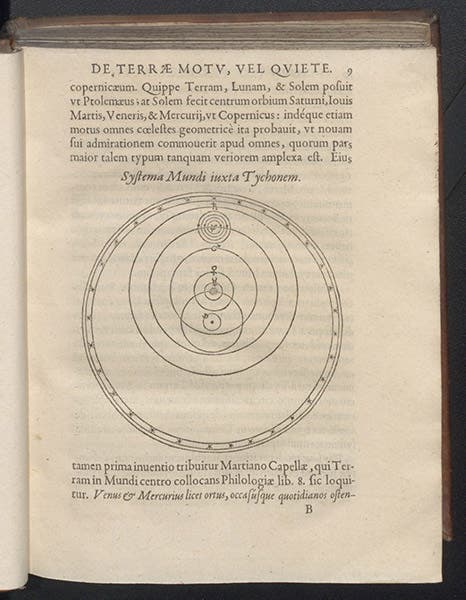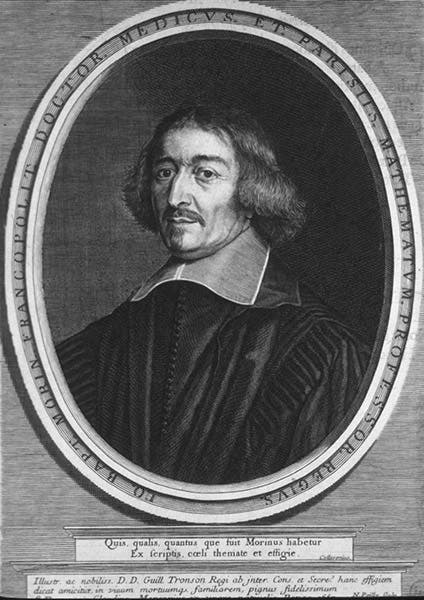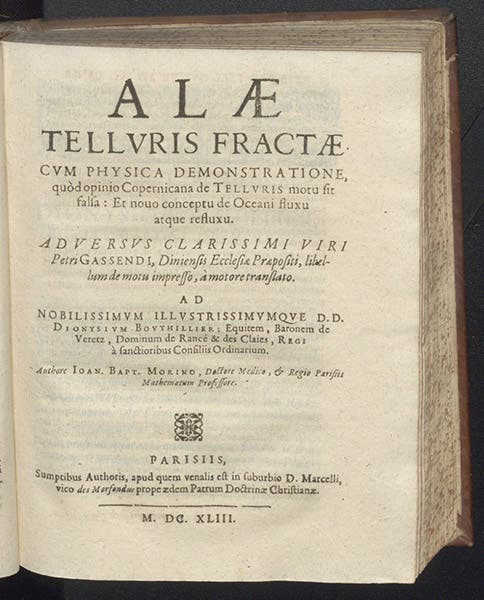Scientist of the Day - Jean-Baptiste Morin
Jean-Baptiste Morin, a French astronomer, mathematician, and astrologer, was born Feb. 23, 1583, in Villefranche, in the Beaujolais. He spent most of the first 47 years of his life working for various patrons, such as the Bishop of Boulogne and the Duke of Luxembourg, before being appointed professor of mathematics at the College Royal in Paris in 1630, a prestigious position for which he really had no qualifications, so one of his patrons must have had considerable pull with the syndics.
About the same time, Morin began to get involved in the Copernican debate as to the proper arrangement of the Sun, Earth, Moon, and planets in the cosmos. Galileo had yet to publish his Dialogo, but Philippe van Lansberge had written a treatise in Dutch in 1629, translated into Latin in 1630, called (here translating) Commentaries on the Daily and Annual Motion of the Earth (we have both the Dutch and Latin editions in our collections), which was thoroughly Copernican, and Morin promptly attacked that book in print in 1631. When Lansberge was defended by his son, Morin criticized that work, in 1634. When Pierre Gassendi defended both Lansberge and Galileo, whose Dialogo appeared in 1632, Morin then went after Gassendi.
Well, all this is nothing special – many people took verbal arms against Copernicanism. But Morin has a special place in my heart, for two reasons, one having nothing at all to do with Morin as anti-Copernican. We will deal with that first. We have in the Linda Hall Library a marvelous sammelband. This is a librarian's word for a collection of books or treatises that were published independently, but which someone then had bound up in one volume. We have quite a few sammelbands in our collections, but the one that concerns us today has four anti-Copernican books bound up together, all published between 1631 and 1643, and three of them were written by Morin. The fourth was published by a contemporary, Libert Froidmont.
Sammelbands are highly sought after by collectors, because they offer the opportunity to acquire three or four (or eight or ten) books on one subject, all at once, and sammelbands often include obscure books that rarely come on the market. So it is a pleasure to have three anti-Copernican books by Morin within one pair of boards, and the Froidmont is an added bonus.
The second reason I am fond of Morin is that he knew how to write a chatty and provocative title, which became a lost art in the 18th century. We show you here the title pages from all three Morin treatises in our sammelband, so you can see the Latin titles, which we will translate. The first book, with the short title Famosi et antiqui, was the inaugural attack of 1631. The first part of the title translates as: The Long-awaited Solution to the Famous and Ancient Problem Concerning the Motion or Immobility of the Earth (third image). This treatise, by the way, contains diagrams of the three chief world systems that were vying for attention: Ptolemaic, Copernican, and Tychonic. Morin was partial to the system of Tycho Brahe, which was geocentric yet had all the other planets moving about the sun. We show Morin’s diagram of the Tychonic system as our first image.
The second Morin treatise, Responsio pro telluris quiete (1634), translates as:
Response for the Immobility of the Earth to the medical doctor Jacob Lansberg’s Apology for the Motion of the Earth (fourth image).
And the third, Alae telluris fractae (1643) reads in translation: The Broken Wings of the Earth, with a Physical Demonstration that the Copernican Opinion of the Motion of the Earth is False, and a New Concept of the Ebb and Flow of the Tides, against the most distinguished man Pierre Gassendi… (fifth image). I really like that title.
We have 13 books by Morin in our collections, including several more that are diatribes against other defenders of Copernican heliocentrism but are not included in the sammelband. Morin is best known as being an ardent defender of astrology, and his Astrologia gallica (1661) is one of the last extended academic defenses of astrology in an era when other astronomers were turning away from astrological practice. We have that work too. It was published five years after Morin’s death in 1656.
We discussed the fourth treatise in our sammelband, by Libert Froidmont, in a separate post on Froidmont, published four months ago.
William B. Ashworth, Jr., Consultant for the History of Science, Linda Hall Library and Associate Professor emeritus, Department of History, University of Missouri-Kansas City. Comments or corrections are welcome; please direct to ashworthw@umkc.edu.











